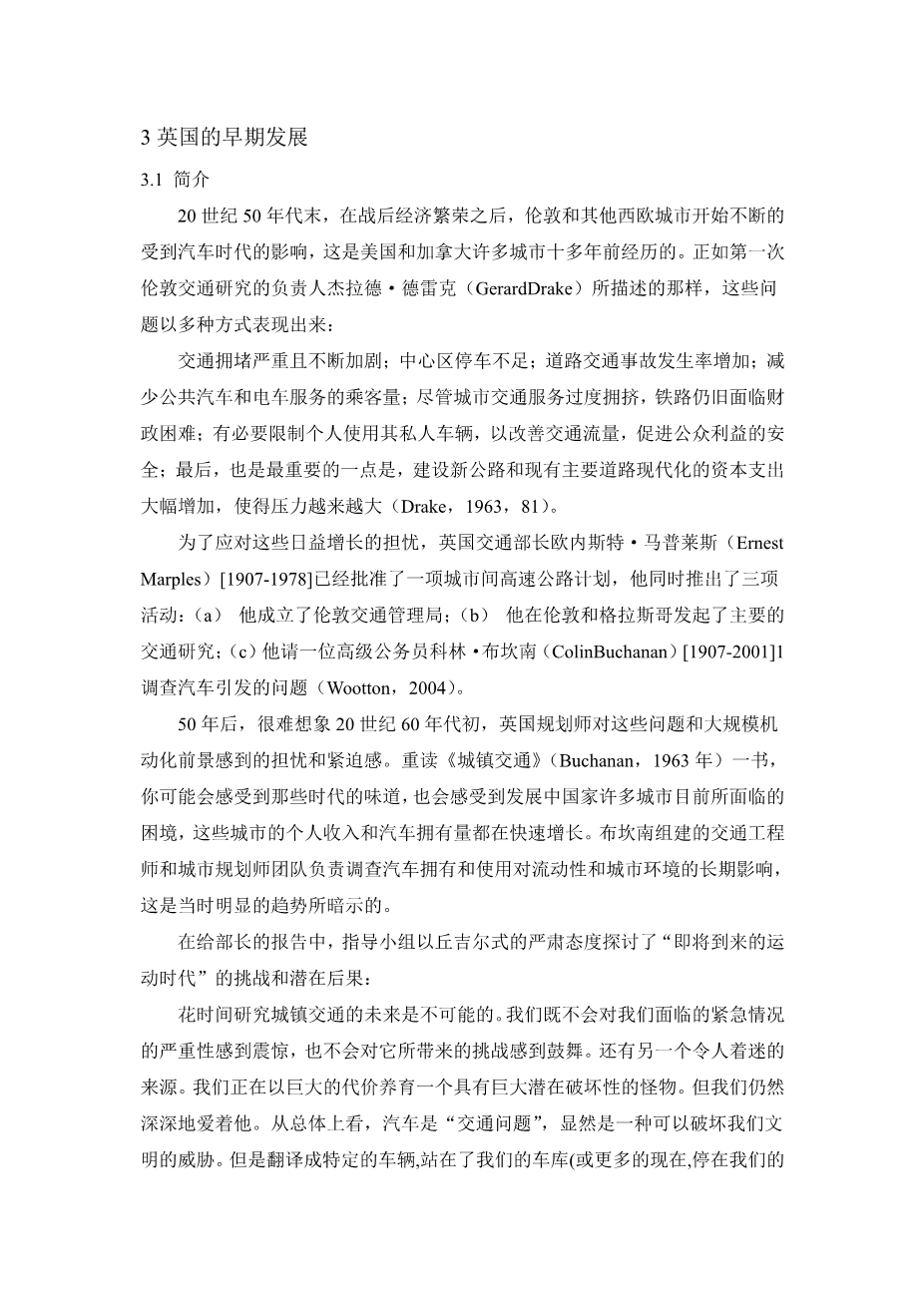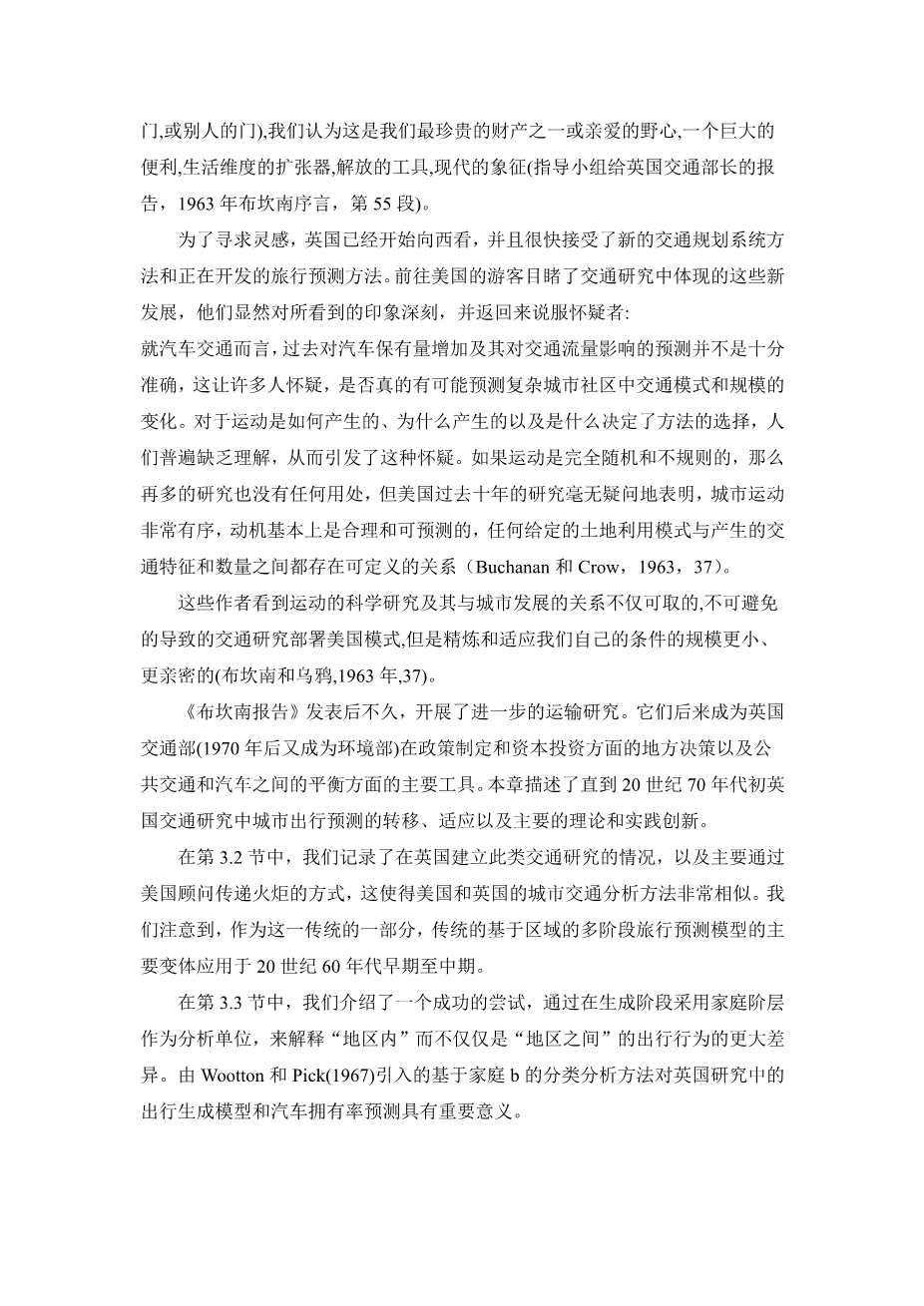3英国的早期发展外文翻译资料
2023-04-08 22:50:57
3. Early developments in the UK
3.1 INTRODUCTION
In the late 1950s, after a post- war economic boom, London and other Western European cities were starting to encounter the growing impact of the motor age that many US and Canadian cities experienced over a decade earlier. The problems were manifest in a variety of ways, as described by Gerard Drake, director of the first London Traffic Study:
acute and growing traffic congestion; central area parking shortages; increased incidence of road traffic accidents; decreasing patronage of bus and tram services; financial difficulties for the railways, even though suburban commuter services are overcrowded; the need for restrictions on the individualrsquo;s use of his private vehicle to improve traffic flow and promote safety in the interest of the general public; and last, but certainly not least, mounting pressures for greatly increased capital expenditures for the construction of new highways and the modernization of existing main roads (Drake, 1963, 81).
In response to these growing concerns, the UK minister of transport, Ernest Marples [1907–1978], who had already endorsed an inter- urban motorway programme, introduced three activities concurrently: (a) he formed the London Traffic Management Unit; (b) he initiated major studies of traffic in London and Glasgow; and (c) he asked a senior civil servant, Colin Buchanan [1907–2001],1 to look into problems arising from the car (Wootton, 2004).
Fifty years later, it is hard to imagine the apprehension and sense of urgency at the start of the 1960s with which British planners approached these problems and the prospect of mass motorisation. Rereading the report Traffic in Towns (Buchanan, 1963), one perhaps gets a flavour of those times and also the dilemmas faced presently by many cities of the developing world that are experiencing rapid rises in personal income and car ownership. The team of traffic engineers and town planners assembled by Buchanan was charged with investigating the long- term consequences for mobility and the urban environment of car ownership and use suggested by trends evident at that time.
In their report to the minister, the Steering Group addressed the challenge and potential consequence of lsquo;the impending motor agersquo; in words of Churchillian gravity:
It is impossible to spend any time on the study of the future of traffic in towns . . . without being at once appalled by the magnitude of the emergency that is coming upon us and inspired by the challenge that it presents. There is another source of fascination. We are nourishing at immense cost a monster of great potential destructiveness. And yet we love him dearly. Regarded in its collective aspect as lsquo;the traffic problemrsquo; the motor car is clearly a menace which can spoil our civilisation. But translated into terms of the particular vehicle that stands in our garage (or more often nowadays, is parked outside our door, or someone elsersquo;s door), we regard it as one of our most treasured possessions or dearest ambitions, an immense convenience, an expander of the dimensions of life, an instrument of emancipation, a symbol of the modern age (Report of the Steering Group to the UK Minister of Transport, preface to Buchanan, 1963, para 55).
For inspiration Britain had already started to look westwards and was quick to embrace the new systems approach to transportation planning and the methods of travel forecasting under development. Visitors to the US who were charged with witnessing these new developments embodied in the transportation studies were clearly impressed by what they saw and returned to convert the doubters:
As far as motor traffic is concerned, predictions about the increase in vehicle ownership and the effect on traffic flows have not been conspicuously accurate in the past, and this has created doubts in many peoplersquo;s minds whether it is really possible to predict changes in the pattern and scale of movement in a complex urban community. Such doubts are fermented by the general lack of understanding about how and why movement is generated and what dictates the choice of method. If movements were completely random and irregular no amount of study would be of any use, but research in the United States in the last decade shows beyond doubt that urban movement is remarkably orderly, that motivation is basically rational and predictable, and that definable relationships exist between any given pattern of land uses and the character and amount of traffic that is generated (Buchanan and Crow, 1963, 37).
These authors saw the scientific study of movement and its relationship to urban development as not only desirable but inevitably leading to the lsquo;deployment of transportation studies on the American pattern but refined and adapted to the smaller and more intimate scale of our own conditionsrsquo; (Buchanan and Crow, 1963, 37).
Soon after the Buchanan Report was published, the inauguration of further transportation studies took place. These were to become major instruments of the UK Ministry of Transport (and after 1970 the Department of the Environment) in policy development and local decisions on capital investment and the balance between public transport and the car. This chapter charts the transfer, adaptation and the main theoretical and practical innovations in urban travel forecasting in UK transportation studies up until the early 1970s.
In section 3.2 we record the establishment of such transportation studies in the UK and the means by which, primarily through US consultants, the torch was passed, resulting in strong similarities in the approach to urban transportation analysis in the US and the UK. We note, as part of this legacy, the main variants of the conventional zone- based multi- stage2 travel forecasting models applied in the early to mid- 1960s.
In section 3.3, we describe a successful attempt to acco
剩余内容已隐藏,支付完成后下载完整资料


英语译文共 5 页,剩余内容已隐藏,支付完成后下载完整资料
资料编号:[590317],资料为PDF文档或Word文档,PDF文档可免费转换为Word




